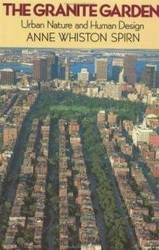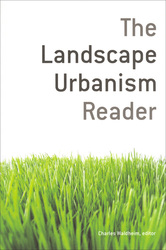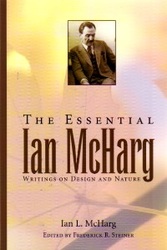1) I must admit that I was not very enthralled with Ian McHarg’s The Place of Nature in the City of Man excerpt. While he of course acknowledges and creates several valid points, I could not help but to be sidetracked by his negative and condescending demeanor (especially when immediately contrasting it with Anne Spirn’s writing; see below). Rather than continuing this comment in a hypocritical manner though, I will focus my efforts on the few intriguing points that he did make. Towards the end of his excerpt he brings to fruition an idea of the “bare minimum environment,” which immediately stood out to me as something to imagine. What would life be like if it was ‘lived’ using the bare minimum environmental needs? Conversely, what would life be like if it was lived using the minimum artificiality (or whatever you see best fit as the opposite of environment)? To me, both images depict an atmosphere that I would not prefer to be subjected to in full. Of course, there are moments when I love being surrounded by nothing by nature, as well as being totally encompassed in a Dave&Busters, surrounded by nothing by artificial technology/entertainment. As I am writing this, I am realizing more and more my overall dilemma with the reading, and that is the fact that it is not about picking extremes, but rather creating a balance/co-existence. While I feel as if McHarg’s overall message may not be to do away with urban environments completely, his method of writing and portraying his argument almost makes it appear as such.
2) Another point of the McHarg’s reading I wanted to make note of was his acknowledgement of Japan’s human ecosystem and their ability to include agriculture in their urban environments. The main thing I took away from this was mankind’s innate ability to “make due.” As countless examples can be found all over the world (and in many aspects), there is an unlimited amount of possibilities when it comes to mankind acting of out necessity. In terms of ecosystems and agriculture, there cannot be a direct comparison of Japan and America because they are 2 totally different environments. Japan has always been rooted in density and geographically dominated regions, whereas miles of open square footage are practically stumbled upon in America’s sprawl. Had America stayed the geographical size of its original 13 colonies, there is not doubt in my mind that we would have developed ways to adapt to our surroundings and succeed. I think our issue in America has always been the fact that we have such a surplus of territory that there is an extensive gap in terms of our actions and the time of their respective consequences; whereas a country as limited in real estate as Japan cannot afford similar actions because it would be the demise of their social, urban and natural environments.
3) Unlike McHarg’s writing, I was very pleased with the Sprin reading as well as her overall approach to urban areas in terms of natural ecosystems. I had a strong appreciation for how she still acknowledged the city as an ecosystem in and of itself, in addition to using non-pessimistic words like “opportunities” and “molding” versus some of the more harsh contrasting language of McHarg. Her explanation of the limitations of nature influencing urban form (as in New York’s utilization of bedrock) was a point that seemed to really resonate with me, perhaps because it was such a different perspective of viewing the natural world. It helped reiterate the fact that ‘ecology’ and ‘natural environment’ do not always constitute an open green park filled with foliage. A second great point was her mentioning of what nature took some 10,000 years to create, mankind was able to vastly influence in 150 years. While this is clearly not the first time this notion has been addressed in the past, the way she structures her writing sparked a new thought process for me. It made me question that if the key to ecological success was somehow directly related to time (i.e. in terms of evolution and progress). While this at first seems very tempting to agree with, I could not help but to snicker at the thought primarily because if that were the case it would be almost impossible for humans to ever be truly ecological (as we are all well aware of mankind’s ‘patience’). However, I then started to wonder “is nature perfect?” Clearly we know that mankind is not, but is nature even? What would these writings be like if they were analyzing the history of natural processes with the same tenacity and intensity as they do human trends? Instead of harping on grid layouts and the erection of concrete/steel towers, it would be criticizing the colossal ice glaciers that covered entire landmasses, moving at a half a snails pace and allowing for no implication life. What sort of thoughts would this spur, I wonder? (Keeping in mind I am not anti-nature by any means, but rather just enjoy re-envisioning how we perceive things sometimes)
4) Another Spirn quote that sparked and idea was her mentioning of “settlers harnessing the power of the sea…” Perhaps it was simply her word choice here, however it made me think back to last week’s conversation of ‘tools’ (i.e. Mitchell’s reading); however this time in terms of nature rather than the internet/technology. How exactly do we view nature? Do we view it as a tool, as Spirn alludes to in her quote? Or do we place it at a higher level of significance (whatever that may be)? Perhaps our current struggles are a result from the fact that we view nature simply as a tool, rather than giving it the respect that it deserves and perceiving it as an organism or process (i.e. placing the same value of mankind on nature).
5) I was also a big supporter of Pollak’s reading and her many ideas of overlapping architecture, landscape, and urbanism. It has a great deal to do with our Theories of Architecture course, in which we recently discussed Rem Koolhaas’s Theory of Bigness (which Pollak later alludes to). I especially enjoyed her comparison of figure/ground versus constructed ground, by which opposition is avoided and overlapping is promoted. Her addressing of multiple scales as a means to eliminate exclusiveness provoked a comparison to Jane Jacob’s idea of mixed-use program as a way of diversifying. While I agree with some of Jacob’s notions of using program to vary certain entities, we have discussed some of the flaw in our Forces that Shape Cities course and I now feel that Pollak’s scalar solution is much more successful in diversifying. By properly including a range of scalar or hierarchical components to design, the best of all worlds involved have a potential to shine successfully simultaneously (not excluding, but including)(i.e. her ‘suppressing the car in order to promote bikes’ example).
2) Another point of the McHarg’s reading I wanted to make note of was his acknowledgement of Japan’s human ecosystem and their ability to include agriculture in their urban environments. The main thing I took away from this was mankind’s innate ability to “make due.” As countless examples can be found all over the world (and in many aspects), there is an unlimited amount of possibilities when it comes to mankind acting of out necessity. In terms of ecosystems and agriculture, there cannot be a direct comparison of Japan and America because they are 2 totally different environments. Japan has always been rooted in density and geographically dominated regions, whereas miles of open square footage are practically stumbled upon in America’s sprawl. Had America stayed the geographical size of its original 13 colonies, there is not doubt in my mind that we would have developed ways to adapt to our surroundings and succeed. I think our issue in America has always been the fact that we have such a surplus of territory that there is an extensive gap in terms of our actions and the time of their respective consequences; whereas a country as limited in real estate as Japan cannot afford similar actions because it would be the demise of their social, urban and natural environments.
3) Unlike McHarg’s writing, I was very pleased with the Sprin reading as well as her overall approach to urban areas in terms of natural ecosystems. I had a strong appreciation for how she still acknowledged the city as an ecosystem in and of itself, in addition to using non-pessimistic words like “opportunities” and “molding” versus some of the more harsh contrasting language of McHarg. Her explanation of the limitations of nature influencing urban form (as in New York’s utilization of bedrock) was a point that seemed to really resonate with me, perhaps because it was such a different perspective of viewing the natural world. It helped reiterate the fact that ‘ecology’ and ‘natural environment’ do not always constitute an open green park filled with foliage. A second great point was her mentioning of what nature took some 10,000 years to create, mankind was able to vastly influence in 150 years. While this is clearly not the first time this notion has been addressed in the past, the way she structures her writing sparked a new thought process for me. It made me question that if the key to ecological success was somehow directly related to time (i.e. in terms of evolution and progress). While this at first seems very tempting to agree with, I could not help but to snicker at the thought primarily because if that were the case it would be almost impossible for humans to ever be truly ecological (as we are all well aware of mankind’s ‘patience’). However, I then started to wonder “is nature perfect?” Clearly we know that mankind is not, but is nature even? What would these writings be like if they were analyzing the history of natural processes with the same tenacity and intensity as they do human trends? Instead of harping on grid layouts and the erection of concrete/steel towers, it would be criticizing the colossal ice glaciers that covered entire landmasses, moving at a half a snails pace and allowing for no implication life. What sort of thoughts would this spur, I wonder? (Keeping in mind I am not anti-nature by any means, but rather just enjoy re-envisioning how we perceive things sometimes)
4) Another Spirn quote that sparked and idea was her mentioning of “settlers harnessing the power of the sea…” Perhaps it was simply her word choice here, however it made me think back to last week’s conversation of ‘tools’ (i.e. Mitchell’s reading); however this time in terms of nature rather than the internet/technology. How exactly do we view nature? Do we view it as a tool, as Spirn alludes to in her quote? Or do we place it at a higher level of significance (whatever that may be)? Perhaps our current struggles are a result from the fact that we view nature simply as a tool, rather than giving it the respect that it deserves and perceiving it as an organism or process (i.e. placing the same value of mankind on nature).
5) I was also a big supporter of Pollak’s reading and her many ideas of overlapping architecture, landscape, and urbanism. It has a great deal to do with our Theories of Architecture course, in which we recently discussed Rem Koolhaas’s Theory of Bigness (which Pollak later alludes to). I especially enjoyed her comparison of figure/ground versus constructed ground, by which opposition is avoided and overlapping is promoted. Her addressing of multiple scales as a means to eliminate exclusiveness provoked a comparison to Jane Jacob’s idea of mixed-use program as a way of diversifying. While I agree with some of Jacob’s notions of using program to vary certain entities, we have discussed some of the flaw in our Forces that Shape Cities course and I now feel that Pollak’s scalar solution is much more successful in diversifying. By properly including a range of scalar or hierarchical components to design, the best of all worlds involved have a potential to shine successfully simultaneously (not excluding, but including)(i.e. her ‘suppressing the car in order to promote bikes’ example).




